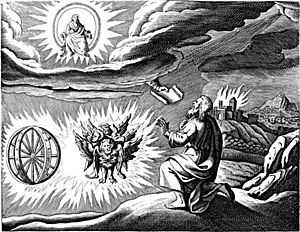Songs of the Underground Railroad facts for kids

Songs of the Underground Railroad were special songs used in the early to mid-1800s in the United States. These songs helped enslaved people escape to freedom along secret paths known as the Underground Railroad. Since it was against the law in most slave states to teach enslaved people to read or write, songs became a clever way to share secret messages. They gave directions, told people when and where to go, and warned them about dangers on their journey to freedom.
Contents
Secret Messages in Songs
Many people believe that some songs had hidden meanings, acting like secret maps or instructions for those escaping slavery.
"Follow the Drinkin' Gourd"
One famous song thought to have secret codes is "Follow the Drinkin' Gourd". The "Drinkin' Gourd" is a nickname for the Big Dipper, a group of stars that looks like a ladle. The two stars at the end of the Big Dipper's "cup" point directly to the North Star.
The repeated line "Follow the Drinkin' Gourd" is often seen as a secret instruction. It told escaping enslaved people to travel north by following the North Star. This path would lead them to free states in the North or even to Canada, where slavery was illegal. Some believe the song even gave a detailed map, guiding people from Mobile, Alabama, up rivers and over land to Paducah, Kentucky.
"Now Let Me Fly"

Another song, "Now Let Me Fly," is thought to have a secret meaning. It mentions the biblical story of Ezekiel's Wheels. This song often talks about a "promised land." It likely helped boost the spirits of enslaved people. It gave them hope that a better place, free from slavery, was waiting for them.
"Go Down Moses"
"Go Down Moses" is a spiritual song that tells the biblical story of Moses leading his people to freedom from slavery in Egypt. Many believe this song was a coded message about the Underground Railroad. In the song, the "pharaoh" is the oppressor. In real life, this would have represented the slave owner. The song may have encouraged enslaved people to seek their own freedom.
Frederick Douglass and Song Meanings
Frederick Douglass was an enslaved person who escaped and later became a famous writer and leader against slavery. In his book, Narrative of the Life of Frederick Douglass, an American Slave (1845), he wrote about how songs sung by enslaved people could have more than one meaning.
Douglass shared an example: "I thought I heard them say,/ There were lions in the way,/ I don't expect to stay/ Much longer here/ was a favorite air and had a double meaning." He explained that for some, it meant going to heaven. But for his group, it meant they were planning to escape to a free state and leave slavery behind.
However, Douglass also noted that slave owners might have suspected their plans. He wrote that singing about freedom repeatedly was one of "many silly things" they did that could "awaken suspicion." This suggests that even if they used codes, they weren't always perfectly secret.
Fact or Legend?

While many people believe the stories about secret codes in Underground Railroad songs, some historians are not so sure. They suggest that the idea of these songs containing detailed escape instructions might be a modern urban legend. This idea became popular in the late 1900s and early 2000s.
Skeptics argue that there isn't much historical proof, like old documents or records, to support these claims. Authors who write about these songs often use phrases like "supposed" or "according to folklorists." This shows that even they admit the stories are based more on oral tradition than on hard evidence. These scholars believe that while the songs certainly expressed hope for freedom, they probably didn't contain literal escape instructions.
However, there is some evidence that Harriet Tubman, a famous conductor on the Underground Railroad, did use at least two songs as codes. Her biography, Scenes in the Life of Harriet Tubman (1869), quotes her saying she used "Go Down Moses" as a code to communicate with people escaping from Maryland.
"Follow the Drinkin' Gourd" Theory
The idea that "Follow the Drinkin' Gourd" was a coded map might have come from a folktale. This story was shared in John A. Lomax's 1934 book American Ballads & Folk Songs. In the book, a story from H.B. Parks mentions a sailor known as Peg Leg Joe. He supposedly traveled through the South, teaching this song to young enslaved people. He would then leave special charcoal and mud prints of his foot and peg leg to guide them north. The story says the song described a path from Mobile, Alabama, up the Tombigbee River, and then down the Ohio River.
Songs Connected to the Underground Railroad
Many songs are linked to the Underground Railroad, whether they contained secret codes or simply inspired hope for freedom. Some of these include:
- "Follow the Drinkin' Gourd"
- "Go Down Moses"
- "Let Us Break Bread Together"
- "Swing Low, Sweet Chariot"
- "Steal Away (To Jesus)"
- "Wade in the Water"
- "Song of the Free"
- "Down in the River to Pray"
- "Michael Row the Boat Ashore"
See also
- "Jimmy Crack Corn"
- Slave Songs of the United States
- "The Gospel Train"

